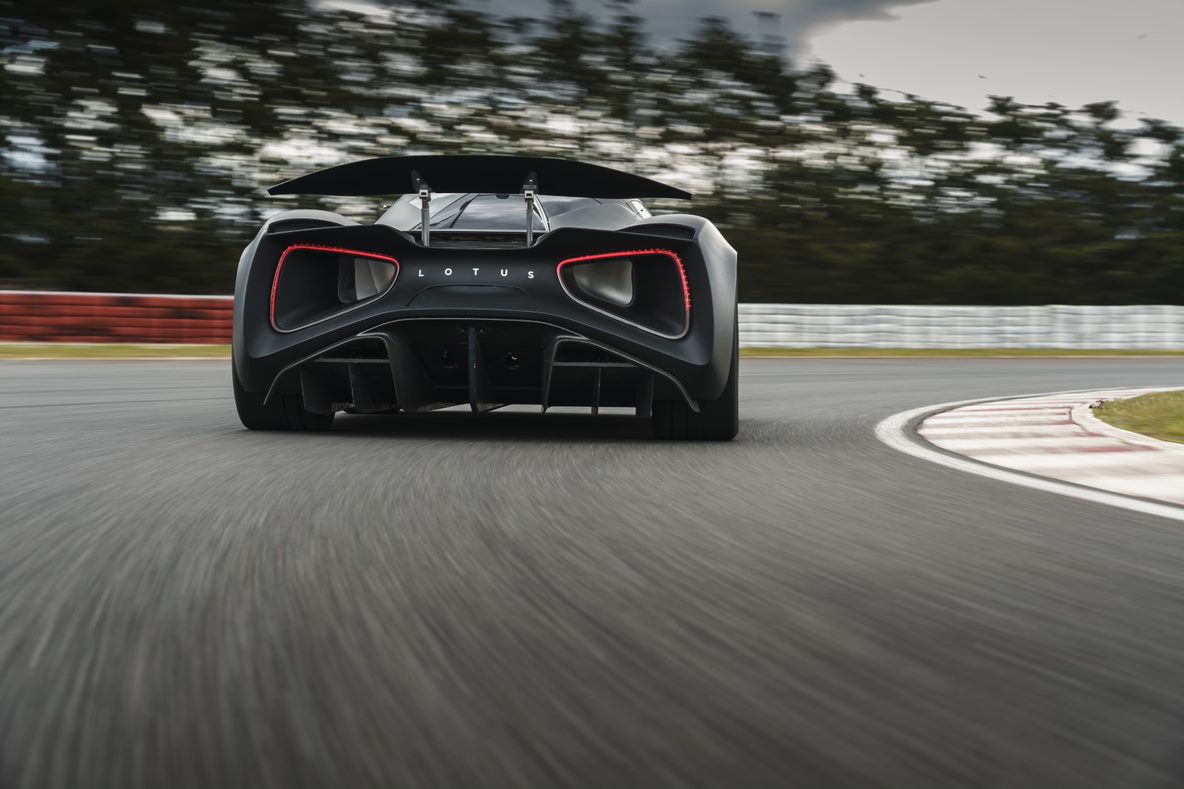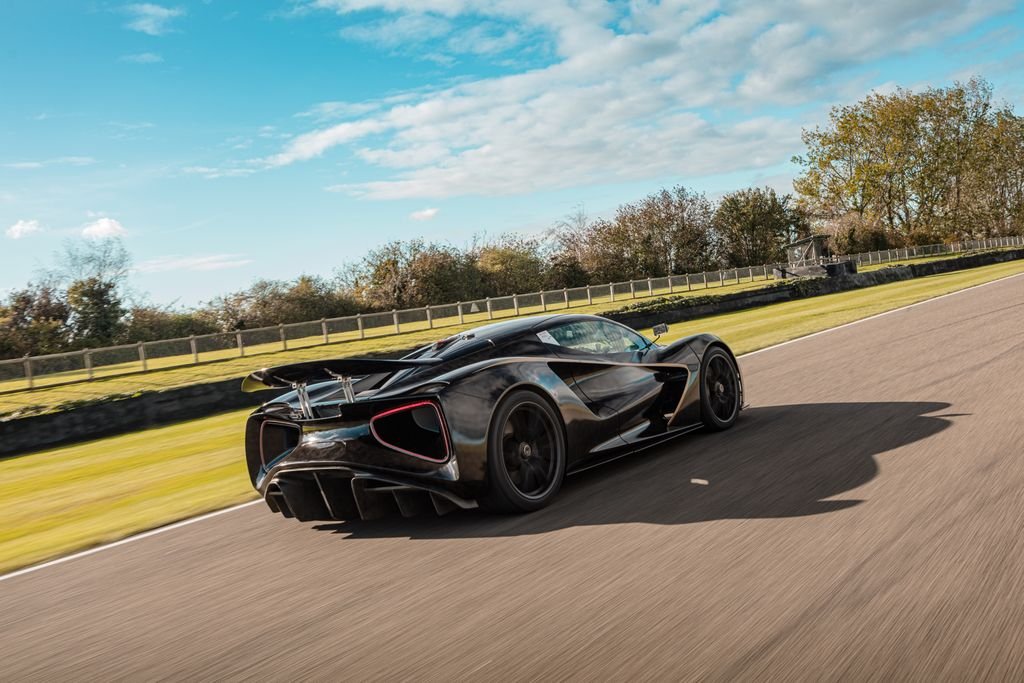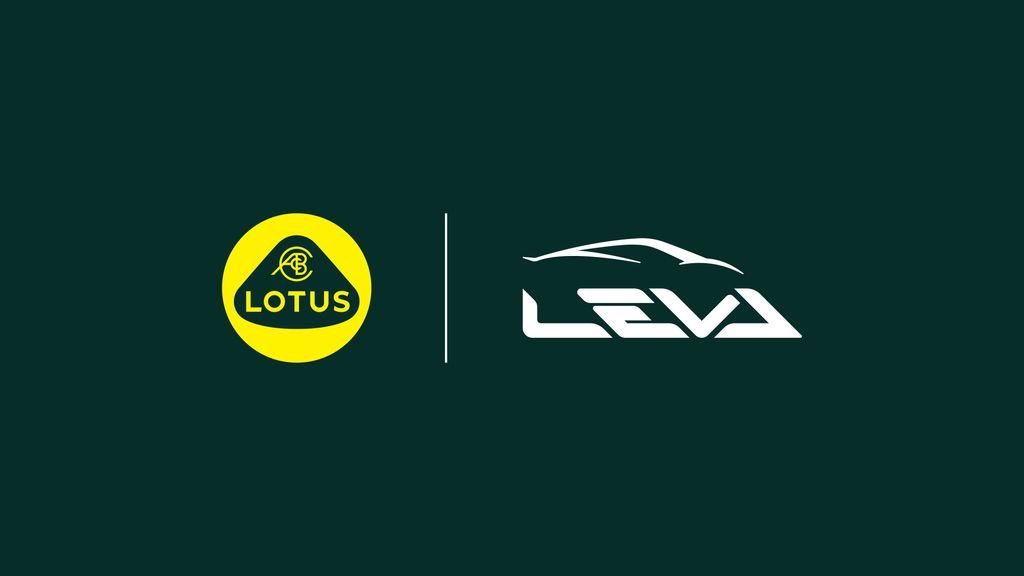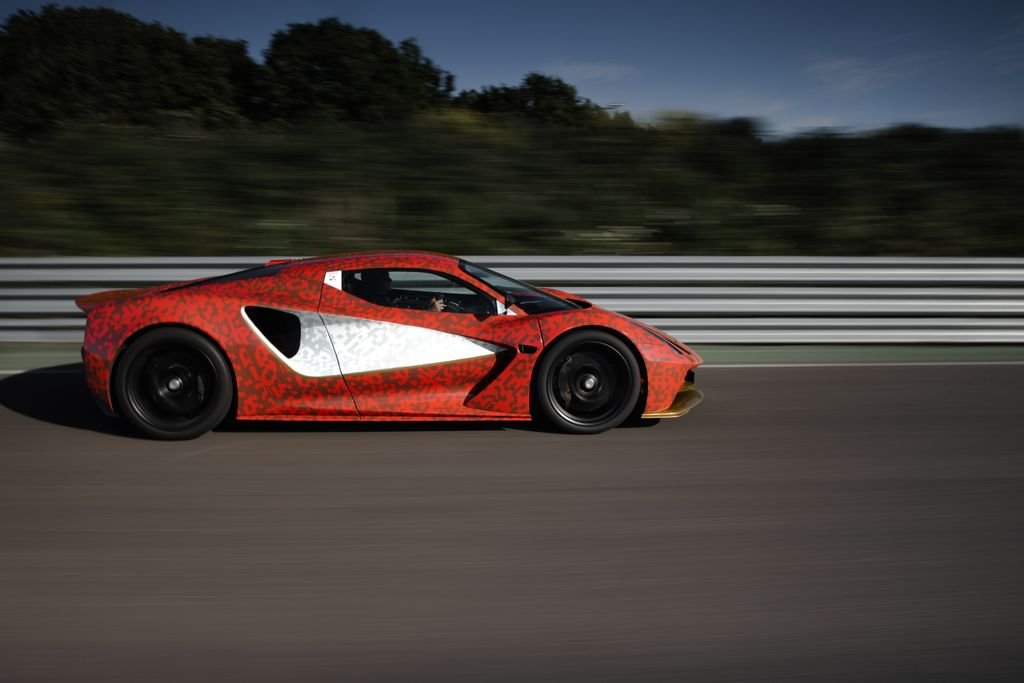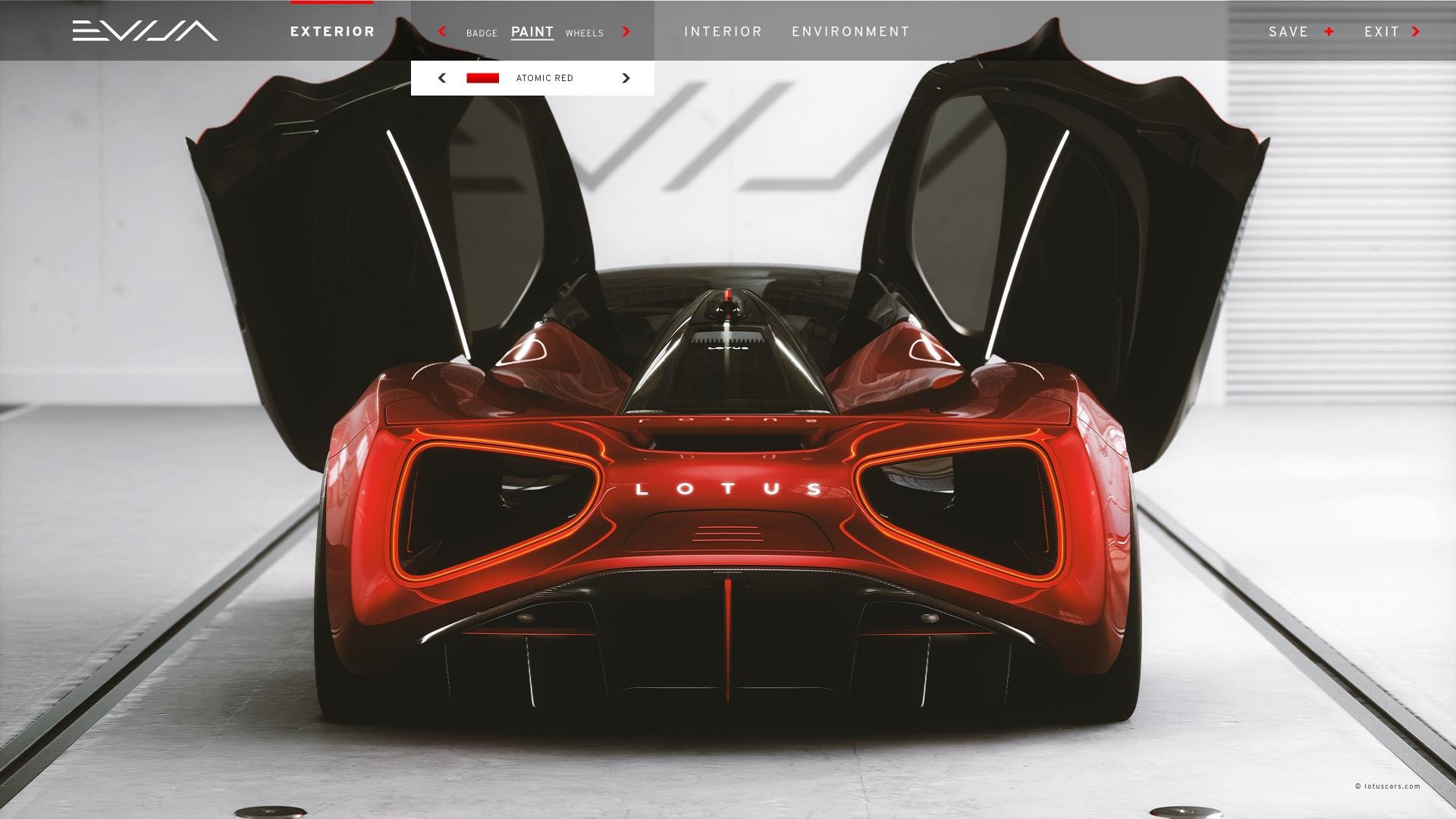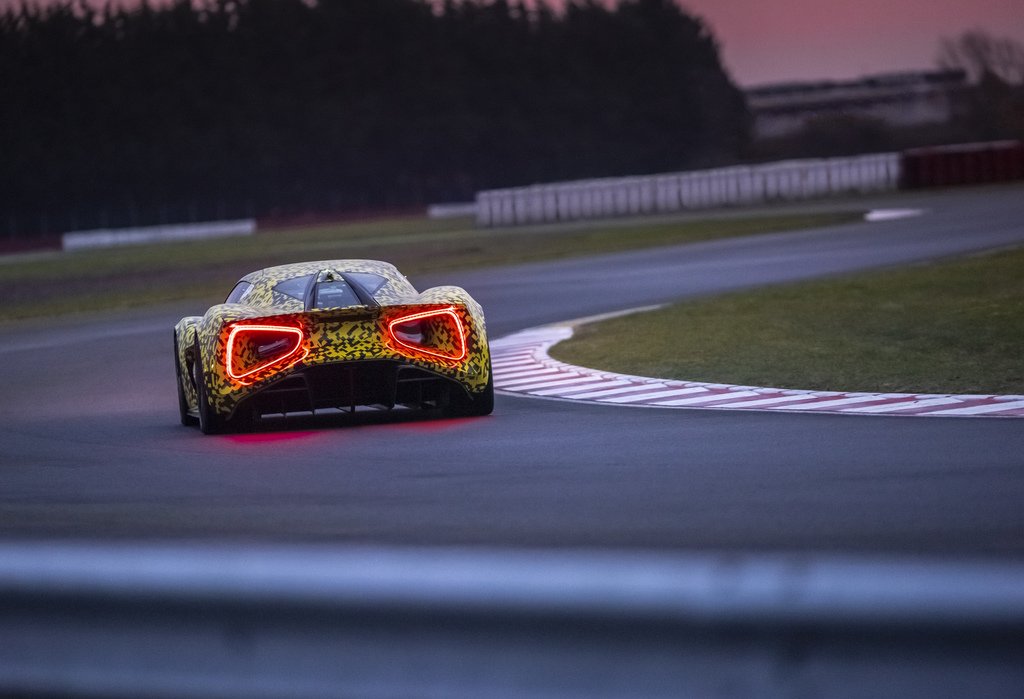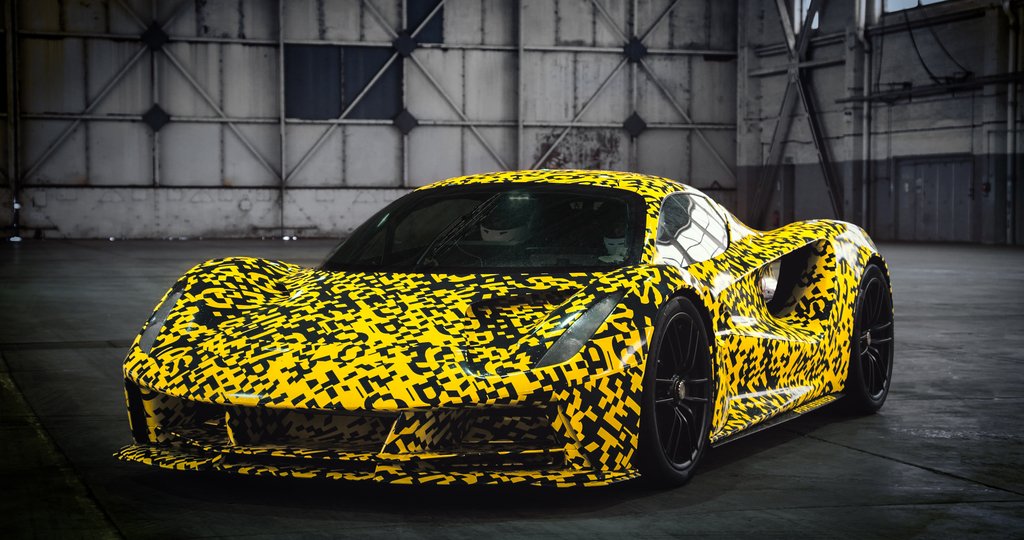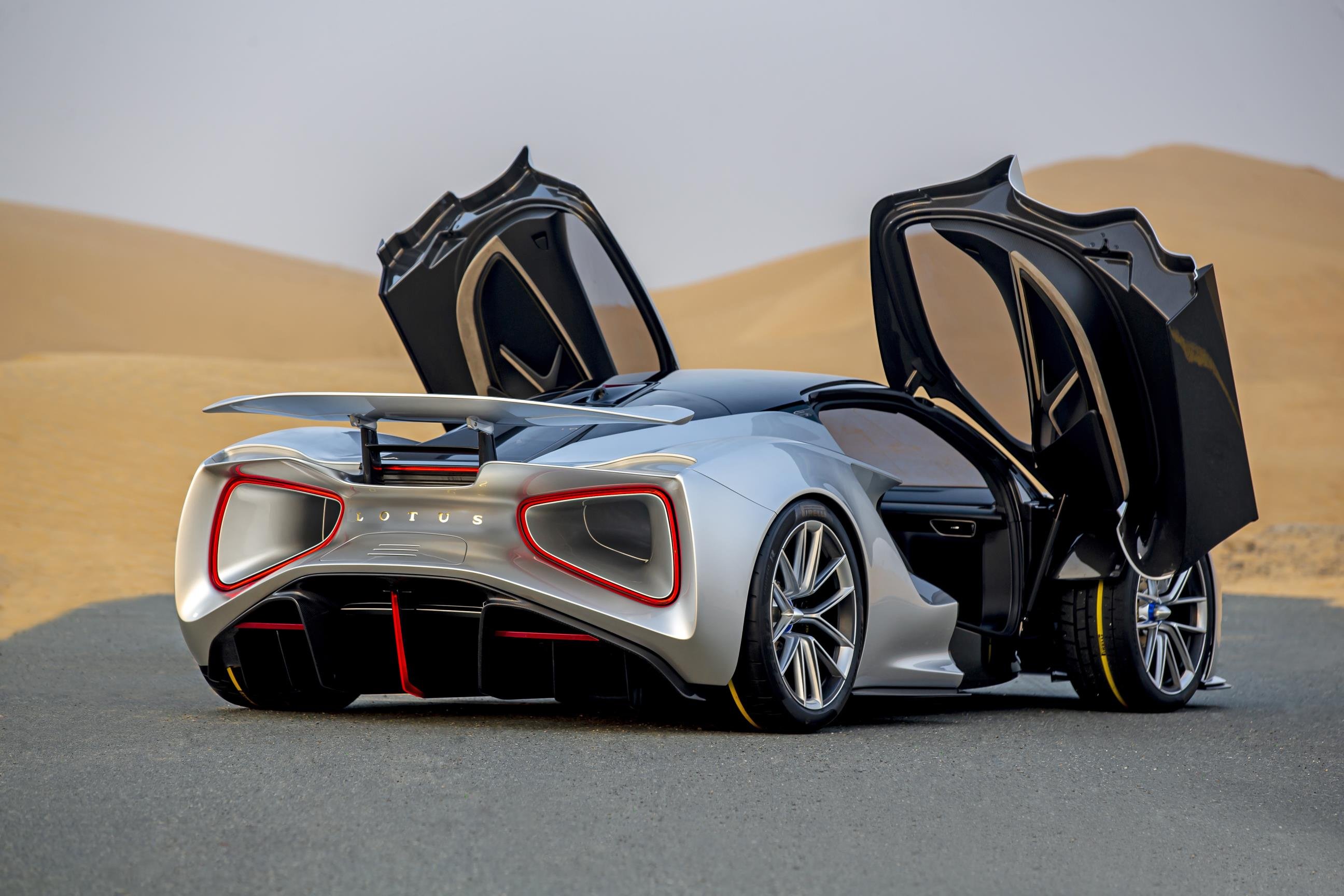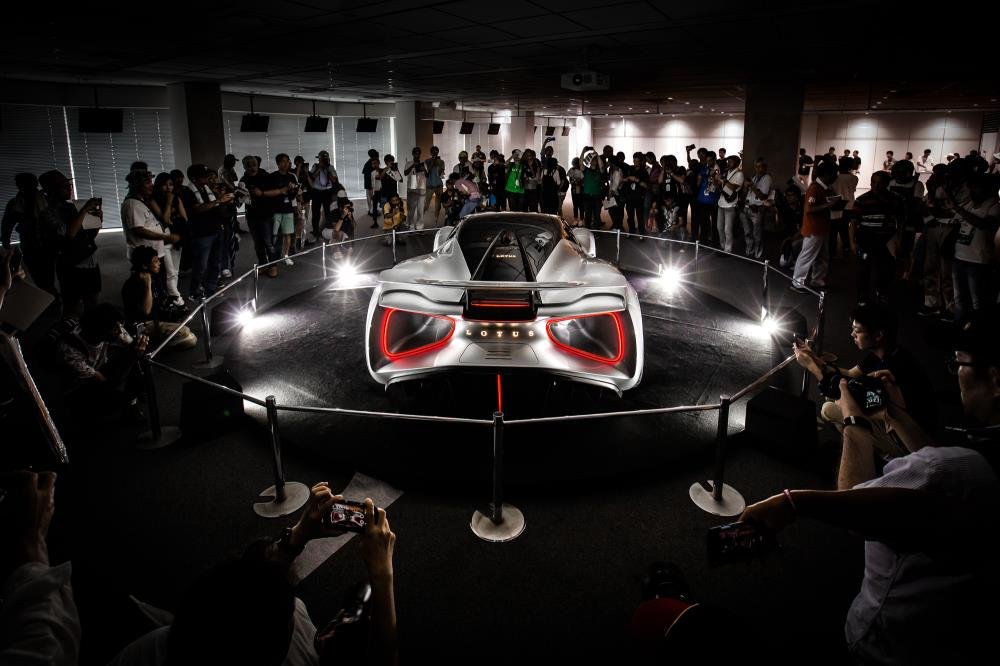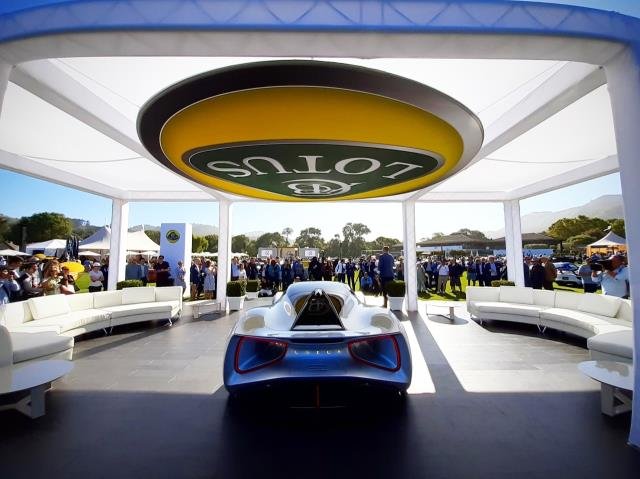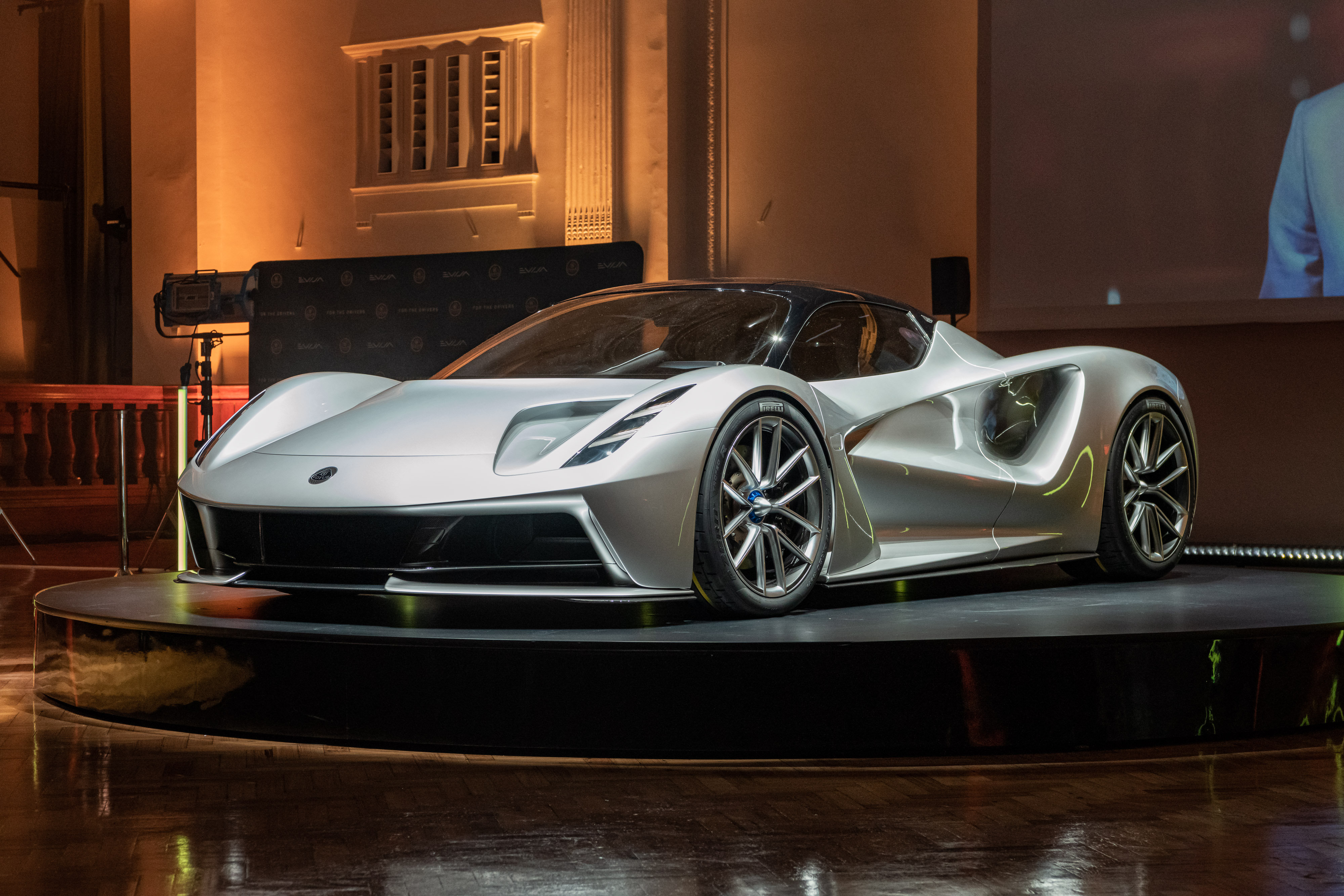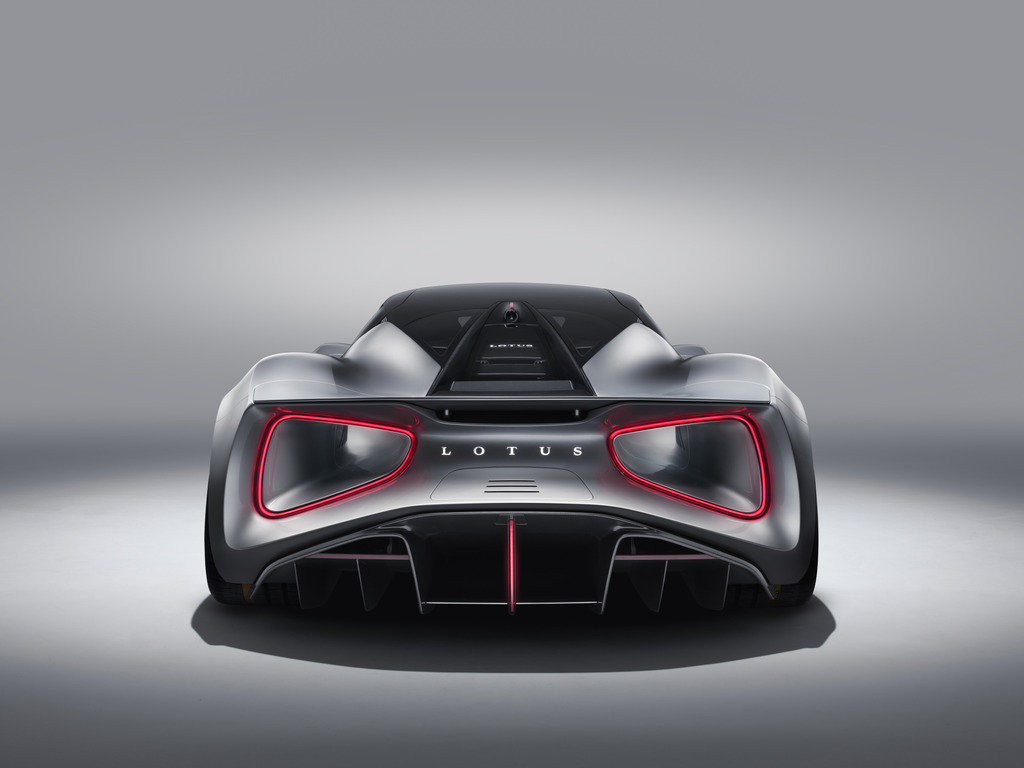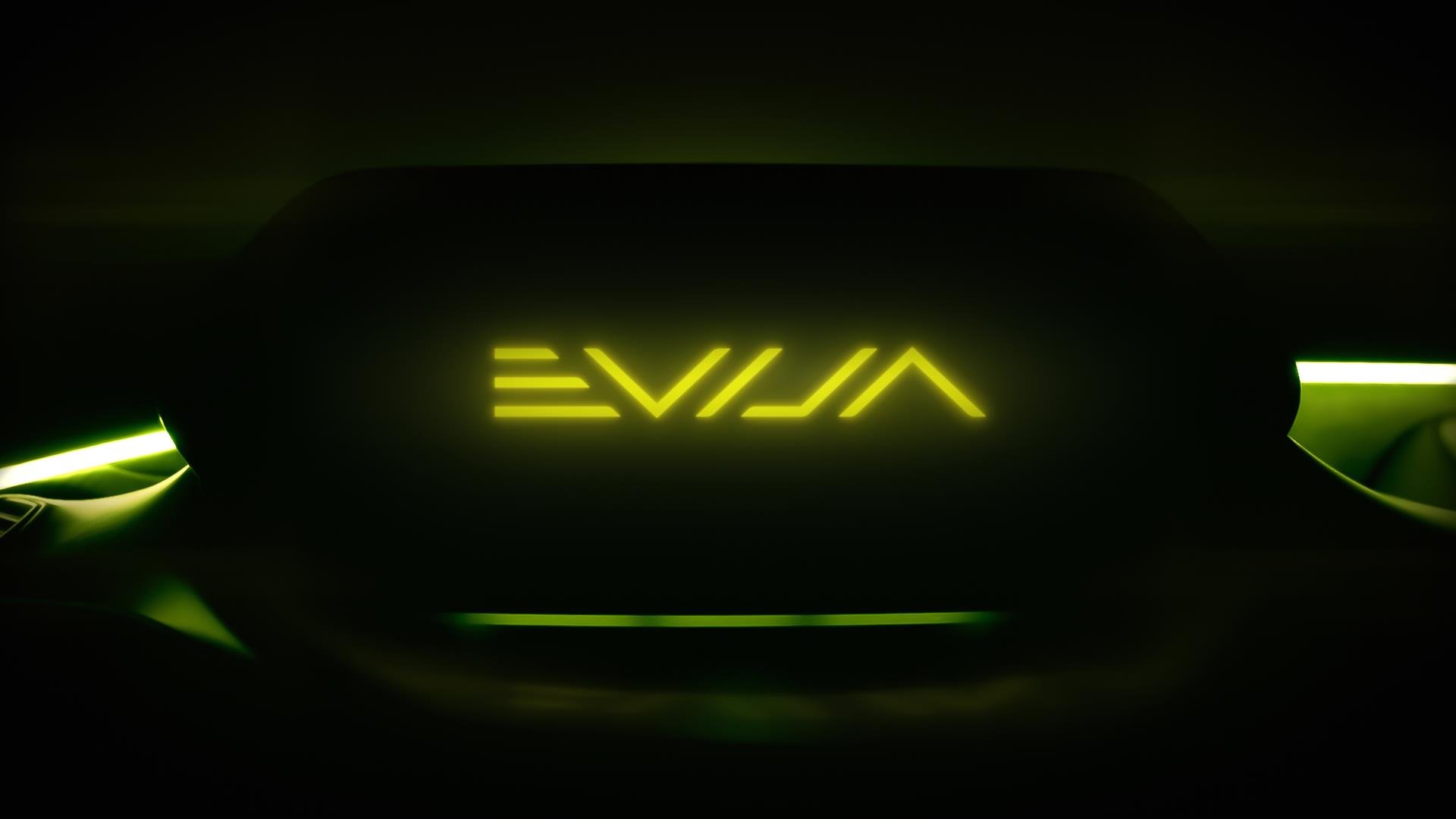|
|
Lotus in the Peak |
| 28th - 30th June 2024 |
Search the Community
Showing results for tags 'evija'.
-
“The thrill of immediate torque, coupled with a lively rear axle and recognisable Lotus agility, makes Evija an unbelievable package already, and that’s just a prototype” – Matt Windle summarises his driving impressions during Evija prototype testing “We’re now 80% through the development programme, and the last 20% is where the magic happens! Refining attributes like ride, handling, steering feel and ultimately, full power. It’s an amazing machine at 80%, at 100% it is going to be truly mind-blowing’ – Gavan Kershaw ( Hethel, UK – 27 April 2021) – As the Evija hypercar programme approaches the final straight before entering production, the Lotus testing team and Matt Windle, Managing Director, Lotus Cars, give their impressions on EP1 – one of several prototypes and the most developed in terms of performance attributes. Matt Windle said: “We have different prototypes focusing on different areas of development. One for build and tech, another for battery management, the other for motors and so on. EP1, which I have driven most recently, is the performance prototype and it does not disappoint. We are still some months from entering series production, but already EP1 has that unmistakable Lotus ‘feel’. Unquestionably a unique and extreme hypercar, but still, somehow, a Lotus. I’m so excited and extremely proud of what the team has achieved.” Gavan Kershaw, Director of Product Attributes and Lotus’ legendary chief test driver, said: “We’re 80% there – in terms of power, in terms of batteries, motors, body. Now, the remaining 20% is about adding the magic, for everything to work in harmony in that unique Lotus way, to deliver the driving experience that we want and that we can be super-proud of. And by proud, I of course mean, mind-blowing. It is a hypercar.” James Hazlehurst, Lead Vehicle Dynamics Engineer, added: “As we enter the final straight of the development programme and start to unleash full power and torque, we are fast-completing the base vehicle dynamics and turning on the active systems one by one – torque vectoring, active aero, traction control and so on – to confirm everything behaves and works together as expected. Then we start to tune the drive modes, delivering the distinctive characteristics for each of the settings. We’ve been doing some of this virtually, working with a simulator partner, and now, as the world is beginning to slowly open up, we’re able to put these learnings into practice in the physical world.” Louis Kerr, Chief Platform Engineer “We’re lucky in that we have our very own 2.25-mile test track, FIA compliant, literally 50 yards from where I’m sat in the all-new Evija assembly hall. I’m not sure many other manufacturers in the world can say that. The car has been designed without any constraints. We have pushed the boundaries of technology and materials at every opportunity, used the best technical partners, applied the latest technology – some of which is only currently available on a Formula One car – and on top of all that we have the most power-dense powertrain in a car. Already it is the fastest road car around the Hethel track, and some legendary cars and drivers have been setting records around here for many years. We’re already going quicker than expected, and in addition we’re looking to exceed the targets we’ve set ourselves on the project in terms of power and torque capacities to absolutely maximise the performance envelope of the car.” Concluding, Gavan Kershaw said: “The Evija is an absolutely phenomenal drive. It has Formula One accelerations but in a closed cockpit, so it’s like a little Group C racer but with the torque and instant delivery of all the power, all the torque and the very latest toolbox of electronic aids. You genuinely start to believe you can defy physics – it fires you around corners like a catapult.”
-
British all-electric hypercar honoured as ‘Product Design of the Year’ at the International Design Awards Awards recognise, celebrate and promote global design visionaries Jury names Evija “the world's most premium sustainable car” All-new ‘Evija in London’ images released to celebrate the award at www.media.lotuscars.com (Hethel, UK – 11 February 2021) – The all-electric Lotus Evija hypercar has been recognised in the prestigious International Design Awards (IDAs), winning the ‘Product Design of the Year’ category. Established in 2007 by a group of leading international designers, visionaries and entrepreneurs as a response to a lack of pure design awards in their field, the IDAs have a truly global profile. They celebrate smart and sustainable multi-disciplinary designs, promoting outstanding creativity while uncovering emerging talent. The award was presented to Lotus after being selected by a panel jury representing each of the five diverse IDA disciplines – Architecture, Fashion, Interior, Product and Graphic Design. The jurors evaluated entries from more than 80 countries, each exhibiting the highest standards of design. The Evija was honoured for its breathtaking ability to stretch boundaries of automotive design. Members of the IDA jury commented that the Lotus Evija “paves a way towards a more sustainable future whilst embodying an exceptional aerodynamic aesthetic”, and that “its seductive style elevates the Evija to be the world's most premium sustainable car”. The Lotus Evija was built with a simple goal – to be the absolute pinnacle of world-class engineering and the most powerful performance car ‘For The Drivers’. It harnesses Lotus’ technical expertise, fine-tuned over more than seven decades, to create a masterclass of automotive excellence. Russell Carr, Director of Design, Lotus, said: “Everyone at Lotus is honoured to receive this award. The Evija is an incredibly important car for Lotus; it is inspired by our innovative past and is the ultimate statement of intent for our ambitious and exciting future. It also sets the standard for a new Lotus design language.” To celebrate the IDA award, Lotus has released a set of new images of the Lotus Evija. Shot on the streets of London prior to the current UK lockdown restrictions, they reveal every facet of the hypercar’s stunning design. Find them at www.media.lotuscars.com
-

Lotus stuns Goodwood SpeedWeek with Evija dynamic public debut
Mark H posted a news article in Group Lotus
(Goodwood, West Sussex, UK – 16 October 2020) – The all-electric Lotus Evija hypercar makes its dynamic public debut at Goodwood SpeedWeek this weekend. The Evija will be in action on the historic race track and will be taking part in a variety of high-octane activities, including the Supercar Run. Three pre-production examples of the Evija are supporting SpeedWeek, one complete in a vibrant Lotus ‘Solaris Yellow’ finish and two prototypes wrapped in stunning black and gold, recalling iconic Lotus liveries of the past. The prototypes also feature a stylised image of the famous West Sussex circuit, accompanied by the words ‘Lotus x Goodwood: Creating History since 1948’ – acknowledging the year of the very first Lotus car and the first motorsport event at Goodwood. Among the first outside of the engineering team to experience Evija is Lord March (Charlie, 25, son of the event host, the Duke of Richmond), who commented: “The Evija is unbelievable – the power, the speed, I’ve never experienced anything like it – it was exceptional. This new dawn of electric hypercars brings ultimate motoring to life for a new generation and a younger audience. The advancement in electric cars over the last 10 years is astonishing. There is a huge amount of growth potential for these machines to continue allowing us to keep enjoying and driving high performance cars. Lotus continues to appeal to both the inner driver and the inner child in all of us – so much fun, and ultimately for the driver to control and enjoy.” Gavan Kershaw, Director of Vehicle Attributes, Lotus, added: “We’re having a great time demonstrating the Evija here at Goodwood. Bringing the cars to an event like this is a welcome break from the hundreds of hours spent on proving grounds, where there’s a huge amount of open space and long straights to test the car’s performance limits. Goodwood is a fast and flowing circuit with numerous undulations in the surface, and so is a fantastic test and demonstration for the Evija as it’s the type of environment where many owners will use the car.” He added: “We hope the TV coverage of the event will show people what an amazing vehicle it is, and we can’t wait to be back next year.” Car fans can see the Lotus Evija on the ITV network, with multiple programmes on different channels across the weekend. See local TV listings for full details. Lotus has also published a new US LOT Blog on the Evija, hosted on the Lotus media website here. It details how elements of the Evija have been consciously designed to meet the exacting standards of company founder Colin Chapman, and how that helps make the car a true Lotus. More than 50 historic Lotus cars are scheduled to take part in Goodwood SpeedWeek. They include: Lotus 25 – the car driven by Jim Clark car during the 1963 F1 season when he won the Drivers’ Championship Lotus 18 – the car in which Sir Stirling Moss won the 1961 Monaco Grand Prix Lotus 49 – the car in which Graham Hill won the Monaco Grands Prix in 1968 and 1969 Lotus 72-5 – Emerson Fittipaldi’s car from the 1970 season Lotus 72-7 – Emerson Fittipaldi’s main car from the 1972-73 seasons, and the car in which he won the most F1 races – five in total Lotus 79 – Mario Andretti’s main car from the 1978 season -

Lotus Wins Uk Government Support and Funding to Deliver Next-generation Ev Architecture
Mark H posted a news article in Group Lotus
(Hethel, UK – 2 October 2020) – An engineering partnership led by Lotus has won UK Government support and funding to develop an all-new next-generation Battery Electric Vehicle (BEV) architecture. The news was confirmed today by the Advanced Propulsion Centre (APC). The funding is awarded as part of the APC’s Advanced Route to Market Demonstrator (ARMD) competition. Funded by the UK Government’s Department for Business, Energy and Industrial Strategy (BEIS), the competition is delivered on behalf of the APC by Cenex, the UK’s Low Carbon and Fuel Cells Centre of Excellence. The successful application is called LEVA, which stands for Lightweight Electric Vehicle Architecture. Led by Lotus, it is targeting the acceleration of and innovation behind new lightweight structures for next-generation BEVs. Incorporating cutting-edge UK-based engineering and digital manufacturing expertise, LEVA will be a showcase for pioneering new BEV chassis and powertrain concepts. Lotus will collaborate with supply chain partner Sarginsons Industries and leading academics from Brunel University London to harness the full ‘light-weighting’ potential of the vehicle architecture. Matt Windle, Executive Director of Engineering, Lotus, commented: “This is great news for our industry and its transition to electrification. As a collaboration between Lotus, Sarginsons Industries and Brunel University London there is a wealth of talent involved, and we are excited to have already begun the project work. Following the launch of the Lotus Evija, our all-electric hypercar, this project is a key building block in our vision to deliver a full range of electrified Lotus performance cars ‘For The Drivers’. Funding of this nature is critical to stimulate the automotive industry and supply chain as both continue to adjust to a rapidly changing landscape.” More details on Project LEVA will be released by Lotus and its partners in due course. -
• Gavan Kershaw, Director of Vehicle Attributes, delivers new insight into driving characteristics and why Evija is a true Lotus • Shot on the Hethel test track, on-board cameras reveal new views of the Evija • Film premieres as Evija wows the crowds at UK’s Salon Prive car show (Hethel, UK – 22 September 2020) – Lotus today reveals further details on the Evija all-electric hypercar in a stunning new film featuring an engineering development vehicle testing on the 2.2-mile track at Hethel. At the wheel is Gavan Kershaw, Director of Vehicle Attributes for Lotus, who provides extensive new commentary on key elements of the Evija project. At almost five minutes long and using on-board cameras to reveal new views of the car, it’s the most detailed insight yet into the dynamic excellence of the Britain’s first all-electric hypercar. The film has been launched as the Evija takes centre stage at this week’s Salon Prive Concours d’Elegance, the UK’s most exclusive motor show. It’s staged in the beautiful gardens of Blenheim Palace, a UNESCO World Heritage site in heart of the Oxfordshire countryside. In the film, Kershaw reveals how from the earliest discussions about what the Evija should be, the goal was to create a hypercar with genuine everyday usability. He reveals new details on the progressive deployment of power and torque though the car’s five drive modes: •Range mode is limited to 1,000PS of power and 800Nm of torque, and intelligently switches the Evija from four-wheel drive to rear-wheel drive to maximise the distance available from the battery and its intelligent power management system. •City provides greater power control and decreases the level of regenerative braking for urban environments. •Tour provides automatically switchable four-wheel or rear-wheel drive, delivering over 1,400PS of power with torque-vectoring. •Sport delivers performance figures of 1,700PS and 1,700Nm linked to stability control systems to increase traction levels. •Track mode is the most extreme, boosting power delivery to the maximum 2,000PS. It delivers the highest level of torque-vectoring with the Evija’s Drag Reduction System (DRS) available on request. The chassis setting is automatically switched to Track. Also included in the film are exclusive dynamic views of the battery pack located immediately behind the two seats, echoing the classic mid-mounted powertrain layout of so many Lotus cars. As Kershaw explains, this creates an optimum weight distribution and makes the Evija exceptionally manoeuvrable as it races towards its top speed of more than 200mph. As with all Lotus cars past, present and in the future, agile handling and exceptional steering are embedded in the brand’s DNA. Kershaw explains they were among the top priorities in setting the performance characteristics of the Evija: “Lotus cars are very nimble, inspiring great confidence when being driven, and the Evija is no different to that,” he states. The Lotus Evija marks the start of an exciting new chapter in the history of an iconic and much-loved British sports car brand. With class-leading in-gear acceleration and an output of 2,000 PS – making it the most powerful series production road car ever built – it sets new standards in the global hypercar market. Satisfying a brief to be the most powerful and dynamically accomplished road car in the history of the company, the Evija represents a thrilling new high water mark for Lotus driving performance. As well as signalling the beginning of a contemporary new Lotus design language, the Evija is a bold statement of intent about the brand’s future ambition to be a truly global performance car company.
-

Lotus Evija: First Details of the All-electric Hypercar Buying Experience Revealed
Mark H posted a news article in Group Lotus
Customers will use a state-of-the-art touch-screen configurator to personalise their Evija Exclusive gift programme will culminate in unique build book Stunning new images and animation reveal all-electric two-seater in three new colours – Atomic Red, Solaris Yellow and Carbon Black View the animation at: As the Evija moves ever closer to series production, Lotus has revealed how customers of the all-electric hypercar are choosing their vehicle’s bespoke specification. The exclusive nature of the 2,000 PS two-seater means every customer journey is unique. Requests for personalisation on every aspect of the Evija – from striking exterior paint colour combinations to highly detailed interior trim – are all part of the enhanced ordering process. Production of the Lotus Evija will start later in 2020, and the first year’s allocation is already designated to customers around the world. The starting point for every car’s specification is an all-new touch-screen configurator. Designed especially for Lotus, its ultra-powerful graphics processor creates stunning high-definition ‘photo-realistic’ images and animations. Developed using advanced gaming software, these allow the buyer to build and personalise their own car from the ground up and visualise it from every angle, inside and out. Thanks to an advanced imaging technique known as ray-tracing, they can even place their Evija into multiple environments around the world to see how localised sunlight levels will affect their choices. The final element is the creation of a fully personalised ‘360 degree fly-through’ film exclusive to each customer. Lotus has released a series of all-new images of the Evija captured from the configurator. They show a car set inside the Lotus Design studios at Hethel, UK – the global home of Lotus since 1966 – and finished in stunning Atomic Red with Carbon Black accent pack. They are accompanied by a new animation which additionally reveals the car in Solaris Yellow and Carbon Black. The configurator is just one element of the Evija experience. At regular intervals during the purchase process, each customer will receive from Lotus a unique gift to reflect the exclusive and technical nature of the Evija. That will culminate in a beautiful hand-crafted build book, packed with stunning imagery of the customer’s individual car during key moments of its assembly. The book will be presented to the customer with their Evija key as part of the handover celebrations. Simon Clare, Executive Director, Global Marketing, Lotus, said: “We know every customer journey will be unique and our highly experienced customer relations team is ready to support any requests. With state-of-the-art digital tools such as the new configurator, we can accommodate customer preferences and requirements from anywhere in the world at the touch of a button.” -
Latest shakedown follows extensive computer simulations, plus multiple sessions in UK and Italy Date: 6 December 2019 Driver: Gavan Kershaw, Director, Attributes and Product Integrity, Lotus Cars Location: Hethel, Norfolk, UK Car: Lotus Evija engineering prototype #2 Pre-test notes: Latest shakedown follows extensive computer simulations, plus multiple sessions in UK and Italy. Engineering prototype #2 is the most advanced of three on test, with customer-specification suspension, EV powertrain, brakes and full carbon-fibre body panels. Features most complete interior yet, with key elements such as production seats and ‘ski slope-style’ floating centre console in place. Fitted with hydraulics to support deployment of car’s active aerodynamics. Driver’s notes: “The car is in a completely pure state at the moment, with no stability control or torque-vectoring. This is so we can evaluate the fundamentals of the chassis, to create the mechanical advantage before the other layers, such as the electronics, are added. It means we can really read the car. Later we can tune what we’ve gained as a mechanical advantage as we add layers. It’s the Lotus way – get the fundamentals right from the start and use baseline aerodynamics, suspension kinematics and geometry to feel the vehicle’s response. I feel really at home in it, it’s really driveable. We assessed the stability and agility through tight corners. We did brisk accelerations to work out the torque split and looked at tyre grip and response. Lotus has always been about ‘input = output’, so if you do something you get a response, and that’s what we’re balancing now. It’s all about the detail so, for example, we’re validating the progressive response from the pedals. We know there’s an enormous amount of torque but drivers will only want it when they ask for it with their right foot. It’s about getting that throttle balance right. We assessed steering-wheel angle versus vehicle response at different speeds to ensure the car feels nimble at 30mph as well as 200mph. Through testing like this we can work on every element, like how connected you feel to the car, the driving position, location of the primary controls and visibility. It’s all about validating how the thousands of hours of computer simulations actually translate into the vehicle. It’s a two-fold process: proving they were the correct targets in the first place, and that the results are accurately translating into the car. It’s also about bringing in experience from other vehicles – what we know from driving Exige and Evora, the Lotus GT race cars – and making sure that core Lotus DNA is all at its absolute best in the Evija. It’s really exciting for me. I love this part of developing any Lotus because it’s proving the mechanical design and the physics behind everything is right, and then working with our engineers to enhance the experience and give the car a true Lotus character. It’s the step-by-step stuff we do with every Lotus – Evija is no different. It’s another chapter in my 30+ years at this company. Yes, I’ve got a big smile on my face because it’s the latest tech, it’s a Lotus and we’re at the forefront again.”
-
New film shows Lotus Evija engineering prototype in action during rigorous global development programme World’s first all-electric British hypercar makes its China debut at Guangzhou Auto Show Comprehensive validation and initial build process well underway ahead of start of production in 2020 (Guangzhou, China – 22 November 2019) – Lotus confirms today that the Evija has entered its initial build phase in the UK, as the hypercar’s global tour continues this week with its Chinese debut at the Guangzhou Auto Show. To celebrate, Lotus premiered a new film during its press conference at Guangzhou. It reveals engineering prototype #2 in high-speed action on a private circuit, and marks a landmark moment – the dynamic world debut of the all-electric British hypercar. The film highlights just how far development work has progressed since the Evija was unveiled last July. It also confirms the pioneering two-seater is on course for start of production next year. Dynamic testing will involve track time at Hethel, UK – the home of Lotus – and on other demanding high-speed and performance handling circuits across Europe. Over the coming months several prototypes will cover many thousands of miles and many hundreds of hours of driving assessment, including on public roads. The Evija – with a target output of 2,000 PS making it the most powerful production series road car in the world – has already been through kinematic and compliance testing and endured multiple dynamic load and suspension simulations. Both the dynamic and static testing are part of a comprehensive validation process designed to guarantee the car will meet customer expectations and demands in key global markets and environments. They are in addition to the extensive programme of computer simulations already completed as part of the hypercar’s development. Gavan Kershaw, Director of Vehicle Attributes, Lotus Cars, commented: “Physical prototype testing at speed is a landmark moment for the Evija and hugely exciting for everyone involved. Our aim is to make sure it’s a true Lotus in every sense, with exceptional performance that’s going to set new standards in the hypercar sector.” Speaking from the Guangzhou Auto Show, Matt Windle, Executive Director, Sports Car Engineering, added: “Everything about the Evija is ‘For The Drivers’. I don’t believe there is another EV in the world that can claim this. From the mid-engined-inspired Lotus layout, to the aerodynamics and downforce, the driving position, vehicle stance and unbelievable performance. It is instantly recognisable as special with a unique character, yet it is unquestionably a Lotus.” Illustrative of the innovative thinking and ingenuity which has always been part of the Lotus DNA, the Evija is a technical tour de force. It continues the legendary Lotus bloodline that’s rich in firsts and technical game-changers, both in the automotive and motorsport sectors. Lotus-Evija-Dynamic-Debut.mp4
-

Evija World Tour Continues as Lotus Hypercar Premieres in the Middle East
Mark H posted a news article in Group Lotus
Lotus Dubai retailer hosts VIP media and invited guests as all-electric Evija debuts in the United Arab Emirates Programme of events includes Lotus Abu Dhabi showroom presentation and private viewings Latest leg of world tour which has already included Monterey Car Week, USA, and Japan Lotus Day (Dubai, UAE – 19 September 2019) – The all-new Lotus Evija hypercar has made its debut in the Middle East as part of a series of exclusive media and VIP events. The covers came off at an unveiling at the stunning Lotus Dubai retail outlet, with Phil Popham, CEO, Lotus Cars and Russell Carr, Director, Lotus Design, presenting the all-electric two-seater to invited guests. They were joined by Karl Hamer, CEO of Adamas Motors, Lotus’ retail partner in the United Arab Emirates, plus other members of senior management from both companies. Phil Popham commented: “It’s fantastic to be back in the UAE, and even better to be here as the Evija hypercar makes its regional debut. The Middle East is well-known for its passion for performance models, and this is an important market as we grow the Lotus brand significantly with new products.” He added: “We believe the Evija will really appeal to Gulf state customers, and we’re developing the car with them – and particularly the local climate – in mind. Real-world testing of prototype vehicles is now underway to ensure optimum performance in every market.” Karl Hamer said: “We are delighted that our customers have the opportunity to view the Evija in the UAE so soon after its global reveal. We are proud to be in one of the most forward-thinking countries in the world, and this all-electric hypercar coming to the UAE supports our nation’s objective to focus on sustainable technologies.” Opened exactly a year ago, Lotus Dubai is on the Emirate’s Sheikh Zayed Road. It’s a 5,000 sq ft state-of-the-art facility capable of showcasing up to 10 models from the Lotus performance car range. The Evija is remaining in the region for several days. It will also appear at Lotus Abu Dhabi – in Sheikha Salama Building, Zayed The First Street, Al Khalidiyah – then complete a programme of private viewings. A technical tour de force, the Evija is illustrative of the innovative thinking and ingenuity that has always been part of the Lotus DNA. With a target output of 2000 PS, it is the world’s most powerful series production road car. It has been designed and engineered in the UK, and will be produced at Hethel, UK, the home of Lotus since 1966, starting next year. Exclusivity is guaranteed, with production limited to a maximum of 130 cars. -

Big in Japan: Evija stuns 2,000 lotus fans on latest leg of world tour
Mark H posted a news article in Group Lotus
Lotus Evija is star of the show at Japan Lotus Day World’s most powerful production car dazzles in front of more than 2,000 Lotus owners and fans Annual event – the biggest for Lotus anywhere in the world – celebrated its 10th year with a parade of 600 cars (Fuji Speedway, Japan – 09 September 2019) – Japan Lotus Day, staged at the iconic Fuji Speedway and the largest annual gathering of Lotus fans anywhere in the world, gave an enthusiastic welcome to the Lotus Evija on the latest leg of its world tour. The event is a car festival held in the foothills of Mount Fuji, 50 miles outside Tokyo, and is the ultimate appreciation of the Lotus brand. The festival was celebrating its 10th anniversary, with the all-electric Evija – the world’s most powerful production road car – taking centre stage in front of more than 2,000 enthusiastic Lotus owners and fans. The event culminated in a stunning parade around the Fuji Speedway circuit, featuring approximately 600 Lotus cars from across the company’s successful road and racing history. It included a 1952 Lotus Six and various race cars from the 1960s, through to numerous examples of the Lotus Elise, Exige, 3-Eleven and Evora. Also attracting attention was a Lotus 78, a championship-winning F1 car which took seven wins and nine pole positions, and through the genius of Lotus founder Colin Chapman kickstarted the pioneering ‘ground effect’ era of aerodynamic development in F1. The extraordinary number of Lotus cars on display reflects the brand's popularity in Japan, which stems in part from the 1970s when a Lotus Europa starred in a famous serialised adventure and racing ‘manga’ called The Circuit Wolf. The largest annual gathering of Lotus fans and cars anywhere in the world, Japan Lotus Day also features several races series, a concours d’elegance, circuit taxi rides and trade stands. Shigenori Ogura, F1 commentator, journalist and Japan Lotus Day fan, said: “Japanese car enthusiasts are totally in love with Lotus. The fans who come to Fuji show so much passion for the cars – both old and new – that it really blows you away.” Prior to the event the Evija was guest of honour at the BH Auction, an exclusive automotive sales event in Tokyo. Attendees were given one-to-one access to the all-electric hypercar in a private viewing area. -
Lotus Evija, the world’s most powerful production car, made its public debut in Monterey this week as thousands of fans flocked to the electric hypercar’s reveal North America’s excited reception of the first all-electric British hypercar, resulted in strong double-figure orders being taken, and most of the initial production for the US market now allocated to customers (Monterey, California – 19 August 2019) – The all-new Lotus Evija hypercar has made its public debut at the world-renowned Monterey Car Week, which drew to a close at the Pebble Beach Concours d’Elegance on Sunday. Evija received plaudits from across the automotive world at Car Week, from the likes of high profile collector Jay Leno, social media star Supercar Blondie and the Petersen Automotive Museum Checkered Flag 200, gaining many new fans, friends and customers along the way. Gordon McCall, Director of Motorsports for The Quail, A Motorsports Gathering, said: “Seeing the Lotus Evija debut at The Quail was fantastic – the brand has an amazing history and it is exciting to see its future unfold with the first of its new sports cars.” Lotus Cars’ CEO, Phil Popham, added: “This is exactly the start we hoped for. Evija is an outstanding and exceptional car – designed and engineered to put Lotus back on the map as the innovator and technical leader that it is. Many orders are now taken, giving us great confidence to hit our planned volume as we enter production next year.” A technical tour de force, the Evija is illustrative of the innovative thinking and ingenuity that has always been part of the Lotus DNA. With a target output of 2000 PS, it is the world’s most powerful series production road car. It has been designed and engineered in the UK, and will be produced at Hethel, UK, the home of Lotus since 1966. Exclusivity is guaranteed, with production limited to a maximum of 130 cars.
-

Evija: Lotus unveils world’s most powerful production car
Mark H posted a news article in Group Lotus
Lotus Evija makes world debut in front of more than 350 international media and VIP guests Convoy of 12 historic and current Lotus cars – all yellow – whipped up interest around London and outside the venue UK Business Secretary calls Evija “a testament to the skills and expertise of the workforce at Lotus” Huge interest on social media: more than 500,000 YouTube views in 12 hours Evija is a bold statement of intent from Lotus, illustrating the company’s ambition Target output of 2000 PS means Evija is world’s most powerful series production road car First all-electric British hypercar and first Lotus with an electrified powertrain (Hethel, UK – 17 July 2019) – Resurgent British sports car maker Lotus has unveiled the Evija, the world’s first all-electric British hypercar, at an exclusive event in London. Hosted at the Royal Horticultural Halls, Victoria, over two sessions, more than 350 VIP guests attended. They were made up of international automotive, business, technology and design media, plus a host of UK business leaders, corporate and commercial partners, government officials, Lotus employees, racing drivers and other distinguished friends of the brand. Also in attendance was a delegation of senior figures from Geely Auto, the world’s fastest growing automotive group and majority shareholder of Group Lotus. Phil Popham, Lotus Cars CEO, and Russell Carr, Design Director, presented the striking two-seater EV hypercar to the audience. Popham described it as a bold statement of intent from the iconic British company, illustrative of its ambition under the stewardship of Geely. He added: “Evija will re-establish Lotus as a leader in terms of engineering and design. It is a hypercar that is built ‘For The Drivers’.” Russell Carr commented: “The Evija is beyond anything Lotus has ever done… beyond anything I’ve ever done. We have created something beautiful, something new, dramatic and unique.” The Rt Hon Greg Clark, Secretary of State for Business, attended the unveiling. He commented: “Our auto industry has long been a source of national pride. The launch of the UK’s first all-electric hypercar – designed, engineered and built here in the UK – is testament to the skills and expertise of the workforce at Lotus. He added: “A key part of our modern Industrial Strategy is to seize the opportunities of the future of mobility, including the move from petrol and diesel to electric vehicles. The Lotus Evija fits with this clear ambition.” Further speeches were made by Mr An Conghui, President of Geely Holding Group and CEO of Geely Auto, and by Minister Ma Hui, from the Chinese Embassy, London. The Evija is the most powerful and dynamically accomplished road car in the history of Lotus, and sets a new standard for Lotus driving performance. It is the first all-electric British hypercar and the first Lotus with an electrified powertrain. It is also the first new model since Geely took control in 2017. A technical tour de force, the Evija is illustrative of the innovative thinking and ingenuity that has always been part of the Lotus DNA. With a target output of 2000 PS, it is the world’s most powerful series production road car. It has been designed and engineered in the UK, and will be produced at Hethel, UK, the home of Lotus since 1966. A maximum of 130 will be built. Full technical details can be found on the Lotus media website at https://media.lotuscars.com/en/models/evija/evija.html News of the unveil event exploded on social media as the car was unveiled. Within 12 hours videos of the Evija had been viewed more than 500,000 times on YouTube. Buzz around the Evija’s debut had been whipped up amongst fans and the public, thanks to a convoy of 12 historic and current Lotus sports cars – all yellow – which had driven around Central London during the afternoon. Crowds of intrigued onlookers, who gathered as the cars lined up outside the venue in the evening, further increased excitement. Speaking as the event drew to a close, Phil Popham commented: “The world premiere of the Evija has been nothing short of spectacular – the perfect way to start a new chapter in this iconic company’s history. I am incredibly proud of what the team has achieved.” He added: “The Evija is a seismic shift for Lotus and signifies the rebirth of one of the UK’s most renowned sports car marques. It will act as a halo for the thrilling new range of Lotus performance cars that will follow.” -

Lotus Evija: the world’s first pure electric British hypercar
Mark H posted a news article in Group Lotus
Lotus Evija – the first all-electric British hypercar – makes its world debut in London Target power output of 2,000 PS makes it the world’s most powerful series production road car Target 0-62 mph (0-100km/h) in under three seconds, top speed over 200 mph (320 km/h) Ultra-lightweight carbon fibre monocoque makes it the world’s lightest production EV hypercar, at 1,680kg Pure electric driving range target of 250 miles (400 km) Mid-mounted battery pack echoes celebrated Lotus mid-engined sports car layout World-first main and dipped beam laser lighting technology Comprehensive personalisation and experiential programmes for customers Designed, engineered and hand-built at Lotus’ famous home in Hethel, UK Cements the UK’s position as the world leader in high-performance, advanced technology automotive manufacturing Lotus Evija production limited to just 130 cars – in tribute to its Lotus ‘Type’ number, 130 – beginning in 2020 LOTUS EVIJA: THE WORLD’S FIRST PURE ELECTRIC BRITISH HYPERCAR (London, UK – 16 July 2019) – The world’s first fully electric British hypercar, the all-new Lotus Evija, has been revealed. With unparalleled performance and a target power output of 2,000 PS, it sets new standards in terms of advanced EV engineering. Quite simply, the Lotus Evija is the most powerful series production road car ever built. Like all Lotus cars throughout the brand’s storied 71-year history, the Evija has been precision-engineered to deliver an outstanding driving experience both on the road and track. It is the most dynamically accomplished model ever built by the company, setting new standards for Lotus driving performance. Above all else, it is ‘For The Drivers’. As a name, Evija (pronounced ‘E-vi-ya’) means ‘the first in existence’ or ‘the living one’. It is highly appropriate; Lotus has an unquestionable reputation for its pioneering approach in both automotive and motorsport. The Evija marks the start of an exciting new chapter in the history of an iconic and much-loved British sports car brand. It is the first hypercar from Lotus, and the company’s first model with an electrified powertrain. As the first completely new car to be launched under the stewardship of Geely – the world’s fastest growing automotive group – its significance cannot be overstated. Exclusivity and desirability go hand in hand in the world of hypercars, and the Evija is blessed with an abundance of both. Production is limited to not more than 130 examples, making it among the most exclusive cars ever launched. It’s a figure set in tribute to the car’s project code, Type 130. Lotus road and race cars throughout the brand’s seven decades of success have been assigned a Type number, and the Evija is no exception. Hethel, close to the historic city of Norwich in the east of England, UK, has been the home of Lotus since 1966. The company has confirmed production of the Evija will begin there during 2020. As well as tempting the world’s hypercar buyers, the car will act as a halo for the rest of the Lotus range – the renowned Elise, Exige and Evora. It will do the same for a range of eagerly anticipated new Lotus performance models to come. Speaking at the unveiling in London, Lotus Cars CEO Phil Popham said: “The Lotus Evija is a car like no other. It will re-establish our brand in the hearts and minds of sports car fans and on the global automotive stage. It will also pave the way for further visionary models.” He added: “This is another amazing moment in the history of our company. The Evija is a true Lotus in every sense – it has been developed with an unwavering passion to push boundaries, to explore new ways of thinking and to apply ground-breaking technologies.” A stunning piece of contemporary automotive design, the Evija features a dramatic Venturi tunnel through each rear quarter, giving it a truly breath-taking presence. Russell Carr, Design Director, Lotus Cars, said: “We studied how Le Mans race cars use air flow creatively to go over, under and around the vehicle, but also through it. This concept of ‘porosity’ is key to the Evija and has enabled us to create a timeless design with exceptional amounts of downforce.” The Evija signals the start of a contemporary new design language for Lotus, which will evolve and reappear on future high-performance cars. Illustrative of the innovative thinking and ingenuity which has always been part of the Lotus DNA, the Evija is a technical tour de force. It continues the legendary Lotus bloodline that’s rich in firsts and technical game-changers, both in the automotive and motorsport sectors. While it is a glimpse of the future from Lotus, it remains true to the company’s DNA and the guiding principles of founder Colin Chapman, who built the first Lotus in 1948. The Evija is the first Lotus road car to feature a one-piece carbon fibre monocoque chassis. The cabin, from the fully adjustable race-style seats to the multi-function steering wheel, is the very pinnacle of motorsport-inspired road car design and technology. At the heart of the Evija is an ultra-advanced all-electric powertrain. It has been developed by technical partner Williams Advanced Engineering, famed for success in motorsport, from Formula One to electrifying the first four seasons of Formula E. The battery pack is mid-mounted immediately behind the two seats and supplies energy directly to four powerful e-motors. This highly efficient system is the lightest, most energy dense, electric power package ever fitted to a road car. With a target weight of just 1,680 kg, it will be the lightest pure electric hypercar ever to go into series production. Engineered for precise and sustained performance, the Evija has five driving modes – Range, City, Tour, Sport and Track. It can race from 0-62 mph (0-100 km/h) in under three seconds and accelerate to a top speed of more than 200 mph (0-320 km/h). Matt Windle, Executive Director, Sports Car Engineering, Lotus Cars, said: “Every element of the Evija has been meticulously analysed and validated. Precision engineering is nothing without human engagement, and that’s why technology with soul is the benchmark for this and every Lotus.” The Evija is priced from £1.7m plus duties and taxes. A £250,000 deposit secures a production slot. Order books are now open through www.lotuscars.com. The Lotus Evija in Detail At first known only by its Lotus Type number – Type 130 – the car has been christened the Lotus Evija (pronounced ‘E-vi-ya’). As a name it is derived from variations of Eve, and means ‘the first in existence’ or ‘the living one’. It is highly appropriate; Lotus has an unquestionable reputation for its pioneering approach in both automotive and motorsport. As the first all-electric British hypercar, the Evija continues that story of innovation. It also signals the start of an exciting new chapter for Lotus under the stewardship of Geely, the fastest growing automotive group in the world. Lotus Cars CEO Phil Popham said: “Evija is the perfect name for our new car because it is the first all-new car to come from Lotus as part of the wider Geely family. With Geely’s support we are set to create an incredible range of new cars which are true to the Lotus name and DNA.” A stunning exterior inspired by nature The most striking element of the Lotus Evija is its exterior. From every angle the full carbon fibre bodywork is stretched taut, appearing shrink-wrapped over the mechanical components. Crouching low to the ground, with a ride height of just 105 mm, the pronounced muscular haunches envelop the teardrop cabin that sinks between them. Taking inspiration from the aeronautics industry, the exterior is a perfectly proportioned blend of fluid forms and crisp lines. This is clearly illustrated by the gently curved but sharp leading edge of the bonnet, which is reminiscent of so many classic Lotus road and race cars. Cues for the Evija’s surface language was also taken from nature. Russell Carr, Design Director, Lotus Cars, commented: “During the initial design stage we spent many hours studying images of geological forms – rocks that had been carved by nature over the centuries. We believe we’ve captured these beautiful, intriguing and elemental lines within the Evija.” True to Lotus founder Colin Chapman’s core belief that every component should serve multiple purposes, the exterior design is also exceptionally efficient on every level. The most obvious example of this – and unquestionably the most dramatic element of the exterior – is the Venturi tunnel which pierces each rear quarter. Inspired by Le Mans race cars, they optimise air flow by directing it through the bodyshell. Aside from creating a breath-taking presence, this design concept – known as ‘porosity’ – aids the delivery of high-energy air flow to the rear of the car. This in turn counteracts the low pressure behind the car to reduce drag. Furthermore, the Venturi effect inside the tunnels pulls air through the rear wheel arch louvres, maintaining air quality in the diffuser. When viewed from the rear of the car, each tunnel is edged with a red LED to create a striking ribbon-style light signature. The result is a stunning visual effect that’s akin to the afterburners on a fighter jet, especially when seen at night. As an extra detail, an LED hidden within each tunnel illuminates its interior. The directional indicators are incorporated into the corners of the ribbon, while the reversing light is provided by the illuminated ‘T’ of the ‘LOTUS’ wordmark above the integrated charging flap. Another key feature of the Evija’s sophisticated aerodynamic system is the bi-plane front splitter. It’s another illustration of form and function working perfectly in tandem. Designed in three sections, the larger central area provides air to cool the battery pack – mid-mounted behind the two seats – while the air channelled through the two smaller outer sections cools the front e-axle. Lotus aficionados may notice a respectful nod to the iconic Type 72 Formula 1 car, with its square front central section and two side wings. Active aerodynamics for exceptional downforce The Evija is the first Lotus road car to ever feature a full carbon fibre chassis. Moulded as a single piece for exceptional strength, rigidity and safety, the full length of the underside is sculpted to optimise downforce. It includes an integrated air diffuser which extends from under the B-pillars to the rear. Active aerodynamics are deployed in the form of a rear spoiler, which elevates from its resting position flush to the upper bodywork, and an F1-style Drag Reduction System (DRS). Both are deployed automatically in Track mode, though can be deployed manually in other modes. The absence of traditional door mirrors plays a part in reducing drag. Cameras integrated into the front wings are electronically deployed on unlock, while another camera built into the roof provides a central view. Images are displayed on three interior screens. Advanced pure EV powertrain means record-breaking power With target figures of 2,000 PS of power and 1,700 Nm of torque, the Lotus Evija is the world’s most powerful production road car. Key to that exceptional power output is the 2,000 kW lithium-ion battery, supplied with its management system by Williams Advanced Engineering (WAE) as part of a joint venture with Lotus to collaborate on advanced propulsion technologies. WAE won a 2018 Queen’s Award for Enterprise for translating its EV expertise from the race track to road-going vehicles. The battery pack is mounted centrally behind the passenger compartment, and its cover is visible through the glass rear screen. This positioning delivers significant advantages in terms of styling, aerodynamics, packaging, weight distribution, occupant comfort and dynamic handling. It also supports fast and convenient servicing and maintenance. Furthermore, the set-up has been designed so that in the future alternative battery packs – for example, to optimise track performance – can be easily installed. Power is fed from the battery pack to a bespoke in-line axial arrangement of two high-power density e-motors. These feature integrated silicon carbide inverters and epicyclic transmission on each axle of the four-wheel drive powertrain. The motors and inverters being supplied by Integral Powertrain Ltd. Four exceptionally compact, extremely light and highly efficient single-speed, helical gear ground planetary gearboxes transfer power to each driveshaft. Measuring a mere 100mm in depth, each gearbox comes packaged with the e-motor and inverter as a single cylindrical Electrical Drive Unit (EDU). With a target power of 500 PS per e-motor, this is the most efficient and elegant engineering solution to deploying so much power with precision. Torque-vectoring, enabled by the four e-motors, provides exceptional dynamic response and agility on the road. This fully automatic, self-adjusting system can instantly distribute power to any combination of two, three or four wheels within a fraction of a second. In Track mode the ability to add more power to individual wheels enables the radius of corners to be tightened, potentially reducing lap times. The Lotus Evija is equipped with ESP stability control to ensure safety in all road conditions, with further grip provided by the four-wheel drive system. A pure steering feel – a vital ingredient of every Lotus – is assured via an electro-hydraulic system. The car is built on a one-piece motorsport-inspired carbon fibre monocoque chassis. It is supplied by CPC, the Modena, Italy-based world-leader in composite technology. Constructed from multiple carbon plies, the manufacturing process is identical to that of an F1 chassis, and ensures the lightest, stiffest, safest and most technically advanced Lotus road car platform ever built. The total weight of the monocoque tub is a mere 129kg. This chassis, coupled with innovative engineering and clever packaging throughout every element of the Evija’s powertrain, has contributed to the class-leading target weight of 1,680kg in its lightest specification. Precision performance guaranteed As with every Lotus, the Evija is 'For The Drivers' and its searing pace is delivered in one seamless, sustained surge. The 0-62 mph (0-100 km/h) sprint is completed in under three seconds, while the top speed is in excess of 200 mph (340 km/h). These headline statistics only tell part of the car’s performance story. Matt Windle, Executive Director, Sports Car Engineering, Lotus Cars, explained: “The Lotus Evija has astonishing acceleration at higher speeds. It takes less than nine seconds to reach 300 km/h which is better than any other direct competitor.” Further performance figures include acceleration from 100-200 km/h in less than three seconds, and 200-300 km/h in less than four seconds. Power can also be delivered over a sustained period. The car’s advanced aerodynamics and four-radiator cooling package keep the battery at an optimum temperature. It means that the Evija is capable of being driven flat out with no derate for at least seven minutes in Track mode. Matt Windle continued: “With the Lotus Evija we have an extremely efficient electric powertrain package, capable of delivering power to the road in a manner never seen before. Our battery, e-motors and transmission each operate at up to 98% efficiency. This sets new standards for engineering excellence.” As part of the development and validation process, Lotus and Williams Advanced Engineering have conducted thousands of hours of virtual testing and digital analysis. This comprehensive programme will ensure the car’s meets its performance targets and exceeds customers’ expectation. As a pure EV the Evija will be ultra-quiet at low speeds. During this time regulations require that it emits a digitally created sound – transmitted via a front-mounted speaker – which will alert pedestrians to its presence. While the flowing lines create a very organic look, Russell Carr, Design Director, Lotus Cars, believes that it is important that the car visually conveys its technical achievements. “When you look through the rear glass, you can see the battery pack cover and the in-board suspension. This link between the human and the precision engineering is essential for a Lotus. We want people to have the sense that they are engaging with the power and performance of the car. We refer to it as technology with soul.” A revolution in charging Not only does the Lotus Evija feature the world’s most powerful automotive drivetrain, it also boasts the world’s fastest charging battery. Thanks to the partnership with Williams Advanced Engineering, the battery has the ability to accept an 800kW charge. Although charging units capable of delivering this are not yet commercially available, when they are it will be possible to fully replenish the battery in just nine minutes. Using existing charging technology – such as a 350kW unit, which is currently the most powerful available – the Evija’s charge time will be 12 mins to 80% and 18 mins to 100%. The car’s range is 250 miles (400 km) on the WLTP Combined Cycle, or 270 miles on the NEDC Combined Cycle. Lotus is in discussions with external suppliers on a charging solution for customers. The CCS2 charging socket is hidden behind a vented flap at the rear of the car. In the same location is a small plaque, reminding customers of the Britishness of the Evija. Motorsport-inspired interior is a technical tour de force The interior of the Lotus Evija is as dramatic as the exterior. Inspired by the technical precision of race car engineering, the dominant characteristic of the cabin is the ‘floating wing’ dashboard which can be glimpsed from outside through the windscreen. The design also echoes the porosity of the exterior. “The shape is inspired by the company’s prototype racing cars of the late Fifties and early Sixties,” explained Russell Carr, Design Director, Lotus Cars. “It has a beauty and an elegance to it, and represents a typically Lotus approach because it performs multiple functions. It houses the instrument panel and air ducts, and is also an integral structural support. It reinforces Colin Chapman’s cast-iron rule that no Lotus component goes along for a free ride.” Access to the cabin is through the two dihedral doors. Handle-free to preserve the sculpted exterior, they’re operated via the key fob. It’s the first time Lotus has used such doors, and while they make for a moment of dramatic theatre they also provide maximum space for getting in and out. An exceptional attention to detail – as people would expect from Lotus – is at the heart of the interior. For example, visible carbon fibre surfaces enhance the sense of light weight, while a thin metal band – engraved with the words ‘For The Drivers’ – runs centrally through the squab of both seats. Once in the car, a switch in the roof console closes the doors. The location aids the minimalist layout of the main control panel and prevents them being activated accidentally. Russell Carr, Design Director, Lotus Cars, explained it’s in tribute one of the most iconic Lotus cars, commenting: “Versions of the Lotus Esprit Turbo featured a huge roof console in the late Seventies and early Eighties. It’s not something you might expect on a contemporary hypercar but Lotus fans will love the connection.” Inside, the cabin strikes the perfect balance between the precise functionality of a track car and the comfort of a road car. The driving position is fully adjustable to accommodate the greatest range of occupants. The elegant carbon fibre shell seats are hand-trimmed with thick Alcantara-finished pads, and feature manual fore / aft adjustment plus electric back operation. The steering column is manually adjustable for both rake and reach. Three-point seatbelts are fitted as standard, with four-point harnesses an option. Built into the bodyshell, close to the occupants’ hip point, are two bespoke storage areas. The design of the steering wheel, similar to that found in an LMP or F1 car, further reinforces the Evija’s sporting intentions. The outer ring is finished in Alcantara as standard with leather available as an option. Buttons are grouped in an intuitive manner and govern functions including phone use, cruise control and DRS deployment. Mounted centrally at the base of the wheel’s hub is the mode controller. There are five modes – Range, City, Tour, Sport and Track – with various of the car’s performance features activated or deactivated depending on which is selected. Ahead of the steering wheel is a state-of-the-art digital display, providing the driver with key information such as mode, battery charge and remaining range. It is the car’s only screen, putting all necessary information in one place. The screen displays essential functions only, with information appearing as required when the appropriate button is pushed, then fading when no longer needed. Further controls are located on the floating ‘ski slope-style’ centre console, which features touch-sensitive haptic feedback buttons. Each is integrated in hexagonal recesses to help guide the driver’s fingers. As the light plays over the surface it creates an almost organic visual effect. The driver can also interact intuitively with the car’s technology via a control wheel. The honeycomb design of the buttons is replicated on indicator stalks and on the surface of the aluminium foot pedals. The Evija’s cabin has been deliberately designed so that the occupants feel they are at one with the vehicle. “At the core of the appeal of any Lotus is that the driver is in sync with the car at all times and almost feels as if they are wearing it,” said Russell Carr, Design Director, Lotus Cars. “Looking out from behind the wheel, it’s a wonderfully emotional moment to be able to see the bodywork outside, both in front and behind you. That’s something we hope to enhance in future Lotus models.” Climate control and a premium infotainment system are fitted as standard. Customers can seamlessly integrate their smartphones via Apple CarPlay and Android Auto, accessing their own music and navigation. Extreme track performance and on-road comfort Calibrated to provide the optimum blend of extreme track performance and on-road comfort, the Evija’s motorsport-derived suspension features three adaptive spool-valve dampers for each axle. Two are corner dampers with a third to control heave. These are mounted in-board to optimise the aerodynamic performance. They are manufactured by Multimatic, specialists in developing high-performance suspension technology for on-road, off-road and motorsport applications including Formula 1. Magnesium wheels provide optimum lightness and strength, and are sized 20 and 21 inches at the front and rear respectively. They are shod with Pirelli Trofeo R tyres, developed specifically to achieve ultimate performance. To deal with the Evija’s extreme performance, the car is equipped with a forged aluminium AP Racing braking system with carbon ceramic discs front and rear. Technology: World-first laser lighting Technology: Connected to the cloud The Lotus Evija is the first production road car in the world to feature laser lights for both main and dipped beams. Produced by Osram, the lighting modules are very compact and will provide an outstanding view of the road or track ahead. The strikingly thin vertical headlamps provide the perfect balance of crystal-like beauty and a highly technical design. Inside the lenses, unique ‘wing-like’ elements form the daytime running lights and directional indicators. The Evija is the first Lotus to provide drivers with a full suite of digital connected infotainment, which will benefit from over-the-air software updates. A powerful on-board modem enables communication to the cloud, and the driver can interact with that data through a Lotus smartphone app. The app will enable drivers to monitor their Evija from anywhere in the world, for example, to check the battery charge status and driving range. It will also support remote use of air-con, to heat or cool the cabin ahead of the next drive. The Evija’s infotainment system includes a chronograph to allow the driver to record their lap times. Connection to the cloud means they can view their performance while at the track and recall previous sessions through the app. The ultimate in personalisation Lotus will offer Evija customers an unparalleled level of personalisation, enabling them to specify the car exactly as they wish. This will include the opportunity to select unique paint finishes, interior trims and detailing. Marquetry-style badging will provide further bespoke opportunities. Lotus has developed the ability to inlay metal elements directly into the carbon fibre bodyshell, so that the badge sits completely flush with the bodywork. Currently the Evija carries a partial Union Flag badge on the C-pillar, signifying its status as a British-built hypercar. However, this could be another flag, a family crest or personal logo. “This marquetry-style badging is similar to that associated with traditional cabinet-making, where you inlay different colours of wood,” explained Russell Carr, Design Director, Lotus Cars. “On the Evija it’s really is up to the customer to choose whatever materials and designs appeal to them.” Lotus is also developing a comprehensive programme of bespoke experiential activities for Evija owners. These will include VIP track days and other high-performance motorsport opportunities. Putting the customer first The Lotus Evija has been designed and engineered at Lotus’ historic home in Hethel, UK, and production will begin in a new dedicated on-site manufacturing facility during 2020. A maximum of 130 examples will be built, guaranteeing exclusivity to match the stunning looks, ground-breaking technology and world-beating performance. They will be sold directly to customers by Lotus, with the global network of 220 retailers in support. Plans to service and maintain the car for each owner are currently in development. The Lotus Evija is priced from £1.7m plus duties and taxes. A £250,000 deposit secures a production slot. Order books are now open through www.lotuscars.com Built in Great Britain, great for Great Britain The UK is already recognised as a world-leader in high-performance automotive production. Lotus has been at the heart of that success for 71 years. The Evija will further cement the global status and reputation of this important UK industry sector, and its associated and diverse supply chain. However, as the first all-electric hypercar from a British car maker, the launch of the Evija sees Lotus deliver an opportunity for new and exciting expansion of the sector. Increasing consumer awareness and demand for the astonishing performance available through EV powertrains means new growth and new skills, and Lotus intends to be key player in that revolution. A true Lotus in every sense The Lotus Evija is faithful in concept and detail to the pioneering principles which company founder Colin Chapman used to build his first car in 1948. In common with every new Lotus, the Evija has been seen by members of the Chapman family. At a private viewing of the Evija, Hazel Chapman – Colin’s widow – commented: “It’s very beautiful and I can’t wait to see it on the road.” As with every Lotus, the Evija features the initials ACBC (Anthony Colin Bruce Chapman) in its badge. Chapman guided the company to astonishing levels of success on the road and track before his untimely death in 1982, aged just 54. Seven Formula One constructors’ championships and six Formula One drivers’ titles tell only a small part of the story. His pioneering approach to engineering led to an incredible range of world-first technical innovations. Type 14: the world’s first composite monocoque production road car (Elite, 1957) Type 25: the world’s first fully-stressed monocoque F1 car, and the first Lotus to win F1 world championship (1963) Type 72: the most successful F1 car of all time and the blueprint for F1 car design for many years (Championship winner in 1970, 1972 and 1973) Type 78: the world’s first ‘ground effect’ F1 car (1977) Type 88: the world’s first carbon fibre F1 car (1981) Type 92: the world’s first active suspension F1 car (1983) Type 111: the world’s first aluminium and bonded extrusion construction production car (Lotus Elise, 1995) Type 130: the Lotus Evija, the first fully electric British hypercar (2019) Lotus Evija: Fact File NOTE: THESE ARE TARGET SPECIFICATIONS Name Lotus Evija (Type 130) Powertrain Pure electric, 4WD Power The target is to be the most powerful production car in the world, at 2,000 PS Battery power 70 kw/h / 2,000 kW Torque 1,700 Nm with torque vectoring 0-100 km/h (0-62 mph) Under three seconds 0-300 km/h (0-186 mph) Under nine seconds Max speed In excess of 200 mph (320 km/h) All-electric range (WLTP Combined) 250 miles (400 km) Charging time (350kW charger) 18 mins Weight 1,680 kg Production run Maximum of 130 cars Overall dimensions (L/W/H) 4,459 / 2,000 / 1,122 mm Price From £1.7m + duties and taxes Reservation process £250k deposit secures a production slot Start of Production 2020 This post has been promoted to an article -

LOTUS STUNS GOODWOOD WITH HYPERCAR SNEAK PEEK… AND REVEALS ITS NAME
Mark H posted a news article in Group Lotus
Lotus confirms Type 130 hypercar is named EVIJA Fans attending the Lotus stand at Goodwood Festival of Speed will be offered a sneak peek at the car Dramatic ‘light show’ experience reveals new design details ahead of the world premiere later this month Classic and current Lotus cars on static and dynamic display, celebrating this year’s Festival theme ‘Record Breakers’ (Goodwood, West Sussex – 3 July 2019) – Lotus has chosen the Goodwood Festival of Speed to reveal the name of its new all-electric hypercar, and is calling on fans to visit its stand for an exclusive glimpse. Due to start production in 2020, the world’s first British EV hypercar will be called the Lotus EVIJA. It marks the start of an exciting new chapter in the history of the iconic British sports car brand. As the first major Lotus model launch under the stewardship of Geely – the world’s fastest growing automotive group – its significance cannot be overstated. Pronounced ‘ev-eye-a’ it means ‘the first in existence’ or ‘the living one’. It is highly appropriate; Lotus has an unquestionable reputation for its pioneering approach in both automotive and motorsport. The Evija – as the first all-electric hypercar from a British car maker – continues that story of innovation. Lotus Cars CEO Phil Popham said: “Evija is the perfect name for our new car because it’s the first hypercar from Lotus, our first electric offering and is the first new model under the stewardship of Geely. The Evija is a Lotus like no other, yet a true Lotus in every sense. It will re-establish our brand on the global automotive stage and pave the way for further visionary models.” Sports car fans attending this weekend’s Festival are invited to visit the Lotus stand – on the main grid – for an exclusive glimpse of the Evija. Hidden from general sight, visitors can join a dramatic ‘light show’ experience that reveals new details and provides the best hints yet of its exterior design. The Lotus Evija will be unveiled in full in London later this month. Since its existence was confirmed at the Shanghai International Auto Show in April, the car has been known only by its Lotus Type number – Type 130. In May Lotus confirmed a maximum of 130 examples will be built at its factory in Hethel, Norfolk, in tribute to its Type number. Also at this year’s Goodwood Festival of Speed are some of the most successful, pioneering and record-setting Lotus cars ever made. The stand is hosting the recently unveiled Lotus Evora GT4 Concept race car – which will be making its dynamic debut up the famous Goodwood hill climb course – as well as examples of the current Lotus range of Elise, Exige and Evora. One historic car is expected to be a real crowd-pleaser. It’s the almost mythical Type 25/R6 Formula One racer, which is the actual car in which legend Jim Clark set the best ever time of 1:20.4 for a lap of the Goodwood circuit. This 1965 record has never been and never will be bettered due to changes in the original configuration of the circuit.



